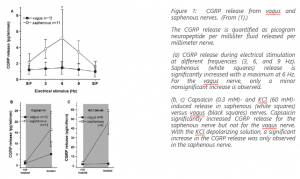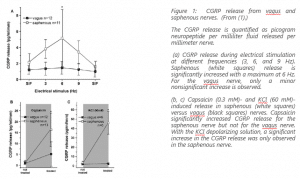Context
Cutaneous nerves and visceral nerves are peripheral sensorial nerves that possess two distinct functions: cutaneous afferent nerves carry information from the body’s external environment, while visceral nerves carry information from the body’s internal environment. As cutaneous and visceral nerves have different physiological roles, it has been suggested that they also exhibit different conductive properties.. In this work, this hypothesis is investigated using the saphenous nerve originating from the lumbar root ganglia, and the vagus nerve arising from the nodosum ganglia as examples for cutaneous and visceral nerves. To compare the conductive properties of the saphenous nerve and the vagus nerve, the CGRP release in these nerves is evaluated in response to chemical and electrical stimulation, with the CGRP Rat ELISA kit (Bertin Bioreagent, France).
Materials
Preparation of mouse saphenous and vagus nerves: The saphenous nerves were dissected bilaterally from their point of leaving the inguinal region to a distance of around 5 mm under the knee. Vagus nerves were exposed and cut from the bifurcation point at heart level to their stomach innervation. The nerve sheaths were removed (both the epineurium and perineurium).
Stimulation procedures: The nerves were placed in a specialized recording chamber (Avere Solutions UG (former Axolent)) between two glass tubes, modified as described in (1). The bath was perfused with SIF (Synthetic interstitial fluid), bubbled continuously with carbogen , and temperature-regulated with a Peltier thermode, continuously throughout the experiment duration. For the electrical stimulation, the cut ends of the nerve were placed through a silicon membrane of the glass tubes. Silver wire electrodes in one of the glass tubes were used as the cathode and anode. The electrical stimulation protocol consisted of stimuli of 0.25 Hz, 3/6/9 Hz, and 0.25 Hz again (for recovery). The chemical stimulation consisted of the application of a 60 mM depolarizing potassium solution (prepared as described in ref ) and a solution of 0.3 mM capsaicin (Sigma Aldrich, Germany) diluted in SIF. Each stimulus was only given once to reduce the desensitization of the nerves. The duration of the stimuli was 5min with a 5min pause between each stimuli for recovery.
ELISA assays: CGRP levels during the electrical stimulation and chemical stimulation experiments were evaluated with the CGRP rat ELISA kit (A05482, Bertin Bioreagent, France) as described in (2). Briefly, the eluates of the CGRP release experiment were mixed 4:1 with 5-fold concentrated commercial CGRP–EIA buffer. The CGRP–EIA had to be run immediately after the release experiment to prevent the loss of neuropeptide. Because of the low levels of CGRP in the vagus nerve, CGRP release from the vagus (but not saphenous) nerve was measured from two nerves threaded together into the recording and stimulating suction electrodes, to obtain CGRP levels above the ELISA kit’s detection threshold. The CGRP release results were divided by two in order to have the per-nerve release. The ELISA assays were un on 96 well-plates, which were photometrically determined using a microplate reader (Opsys MRTM, Dynex Technologies, Chantilly, VA). Results can be seen in Figure 1.


